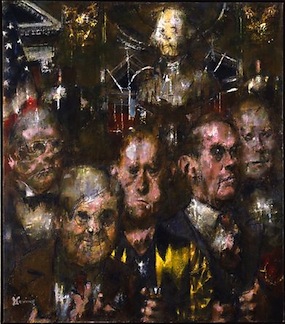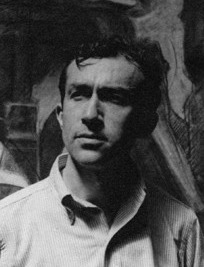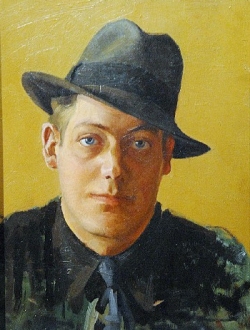Related Research Articles
Abstract expressionism is a post–World War II art movement in American painting, developed in New York City in the 1940s. It was the first specifically American movement to achieve international influence and put New York at the center of the Western art world, a role formerly filled by Paris.

Jack Tworkov was an American abstract expressionist painter.

Adolph Dietrich Friedrich Reinhardt was an abstract painter active in New York for more than three decades. He was a member of the American Abstract Artists (AAA) and part of the movement centered on the Betty Parsons Gallery that became known as abstract expressionism. He was also a member of The Club, the meeting place for the New York School abstract expressionist artists during the 1940s and 1950s. He wrote and lectured extensively on art and was a major influence on conceptual art, minimal art and monochrome painting. Most famous for his "black" or "ultimate" paintings, he claimed to be painting the "last paintings" that anyone can paint. He believed in a philosophy of art he called Art-as-Art and used his writing and satirical cartoons to advocate for abstract art and against what he described as "the disreputable practices of artists-as-artists".

Jack Levine was an American Social Realist painter and printmaker best known for his satires on modern life, political corruption, and biblical narratives. Levine is considered one of the key artists of the Boston Expressionist movement.

Hyman Bloom was a Latvian-born American painter. His work was influenced by his Jewish heritage and Eastern religions as well as by artists including Altdorfer, Grünewald, Caravaggio, Rembrandt, Blake, Bresdin, Ensor and Soutine. He first came to prominence when his work was included in the 1942 Museum of Modern Art exhibition "Americans 1942 -- 18 Artists from 9 States". MoMA purchased 2 paintings from the exhibition and Time magazine singled him out as a "striking discovery" in their exhibition review.

Arthur Polonsky was a figurative painter, draughtsman and educator, known for his explorations of light, water, flight and similarly lyrical motifs that, in esoteric and unsettling ways, alluded to myth, fantasy, music, the Bible, or the poetry of Symbolist and Modernist poets like Rimbaud and Rilke. "The dialogue between color, texture and subject is always alive" the late artist Barbara Swan Fink says of his work. His drawings, in particular, "have the excitement of a direct response to a subject, a daring use of line or tone, a sense of charged intensity. His portrait drawings not only have likeness but express a mood that is part artist, part model.
Karl Zerbe was a German-born American painter and educator.
Nicholas Marsicano was an American painter and teacher of the New York School. His work was primarily based on the female figure.

Esther Geller was an American painter mainly associated with the abstract expressionist movement in Boston in the 1940s and 1950s. She was one of the foremost authorities on encaustic painting techniques.

American Figurative Expressionism is a 20th-century visual art style or movement that first took hold in Boston, and later spread throughout the United States. Critics dating back to the origins of Expressionism have often found it hard to define. One description, however, classifies it as a Humanist philosophy, since it's human-centered and rationalist. Its formal approach to the handling of paint and space is often considered a defining feature, too, as is its radical, rather than reactionary, commitment to the figure.

Jack Wolfe was a 20th-century American painter most known for his abstract art, portraiture, and political paintings.
Jason Berger was a Boston landscape painter, connected to Boston Expressionism. He painted from nature, en plein air, and used favorite motifs in abstract paintings, referred to as "studio paintings". He, also, enjoyed woodcuts which were predominantly printed in black and white. Known for his humor, love of jazz, and his upbeat approach to painting, “his work expresses the joy of life and love of place”.
Boston Expressionism is an arts movement marked by emotional directness, dark humor, social and spiritual themes, and a tendency toward figuration strong enough that Boston Figurative Expressionism is sometimes used as an alternate term to distinguish it from abstract expressionism, with which it overlapped.

Barbara Swan (1922–2003), also known by her married name, Barbara Swan Fink, was an American painter, illustrator, and lithographer. Her early work is associated with the Boston Expressionist school; later she became known for her still-life paintings in which light is refracted through glass and water, and for her portraits. She is also known for her collaboration with the poets Anne Sexton and Maxine Kumin, and for her archived correspondence with various artists and writers.

Ture Bengtz was a Finnish-American artist associated with the Boston Expressionist school, an influential teacher at the School of the Museum of Fine Arts in Boston, and director of the Art Complex Museum in Duxbury, Massachusetts. He also had a television show, "Bengtz on Drawing," on Boston's PBS station in the late 1950s.
Lawrence Kupferman (1909–1982) was an American painter associated with the Boston Expressionist school in the early 1940s, and later, with Abstract Expressionism. He chaired the Painting Department at the Massachusetts College of Art, where he was known for introducing innovative practices and techniques.
The Boris Mirski Gallery (1944–1979) was a Boston art gallery owned by Boris Chaim Mirski (1898–1974). The gallery was known for exhibiting key figures in Boston Expressionism, New York and international modern art styles and non-western art. For years, the gallery dominated with both figurative and African work. As an art dealer, Mirski was known for supporting young, emerging artists, including many Jewish-Americans, as well as artists of color, women artists and immigrants. As a result of Mirski's avant-garde approach to art and diversified approach to dealing art, the gallery was at the center of Boston's burgeoning modern mid-century art scene, as well as instrumental in the birth and development of Boston Expressionism, the most significant branch of American Figurative Expressionism.
Melvin Joel Zabarsky (1932–2019) was an American figurative painter who created representational work in the narrative tradition. Known for a bright, bold palette, his work often explores political, historical and cultural themes to surreal and realist effect. In a six-decade career marked by several distinct phases, Zabarsky's imaginative use of color, formal experimentation and commitment to narrative organization in both traditional and avant garde styles are hallmarks of his work. In an interview with the British philosophers Donald and Monica Skilling, he said, "I'm discovering history, or a narrative, within a painting, as I go along."
Joyce Reopel (1933–2019) was an American painter, draughtswoman and sculptor who worked in pencil, aquatint, silver- and goldpoint, and an array of old master media. A Boris Mirski Gallery veteran, from 1959–1966, she was known for her refined skills and virtuosity. She was also one of very few women in the early group of Boston artists that included fellow artist and husband Mel Zabarsky, Hyman Bloom, Barbara Swan, Jack Levine, Marianna Pineda, Harold Tovish and others who helped overcome Boston's conservative distaste for the avant-garde, occasionally female, and often Jewish artists later classified as Boston expressionists. Unique to New England, Boston Expressionism has had lasting local and national influence, and is now in its third generation.

Irwin Rubin was an American artist and educator known for his colorfully painted wood constructions.
References
- 1 2 "A transformative force in Yale art, Chaet dies". Yale Daily News. Retrieved 2017-07-30.
- ↑ "Collection: Bernard Chaet". Metropolitain Museum of Art.
- ↑ "Collection: Bernard Chaet". Museum of Fine Arts Boston. Archived from the original on 2017-08-28. Retrieved 2017-07-28.
- ↑ "Collection: Bernard Chaet". Art Institute of Chicago.
- ↑ "Collection: Bernard Chaet". Smithsonian American Art Museum.[ permanent dead link ]
- ↑ "Collection: Bernard Chaet". Yale University Art Gallery.
- ↑ "Collection". Addison Gallery of American Art.
- ↑ "Bernard Chaet Bio". Alpha Gallery. Retrieved 2017-07-30.
- ↑ "Chaet, Bernard". National Academy Museum. Archived from the original on 2017-08-28. Retrieved 2017-07-30.
- ↑ "Bernard Chaet papers". Smithsonian Institution.
- ↑ "Nick Capasso essay on Boston Expressionism". Hyman Bloom Info. Retrieved 2017-07-30.
- ↑ Chaet, Bernard (1980). "The Boston Expressionist School: A Painter's Recollection of the Forties". Archives of American Art Journal. 20 (1): 25–30. doi:10.1086/aaa.20.1.1557495. JSTOR 1557495. S2CID 192821072.
- ↑ "In memoriam: Bernard Chaet". YaleNews. 2012-10-24. Retrieved 2017-07-30.
- ↑ Chaet, Bernard (January 1958). Kramer, Hilton (ed.). "Studio Talk". Arts. 32 (4): 62–63.
- ↑ "Oral history interview with Bernard Chaet, 1977 June 18-August15". www.aaa.si.edu. Archive of American Art. Archived from the original on 2012-11-11. Retrieved February 26, 2021.
- ↑ Chaet, Bernard (1960). Artists at Work. Cambridge, MA: Webb Books.